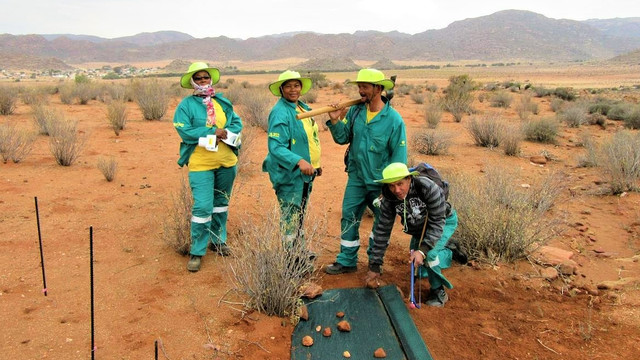Can ecosystem-based adaptation help deliver the promise of Paris?
Ecosystem-based adaptation (EbA) is gaining traction as a way to help manage the threats of climate change. But for the policy community to realise EbA's real potential as a viable response for climate vulnerable communities, we need to plug knowledge gaps on how it works, when and why.


Farmers analyse local maize varieties in the Karst mountains, Southwest China. IIED's work includes participatory plant breeding and community supported agriculture (Photo: IIED)
Under the landmark Paris Agreement on climate change 196 countries committed to try to limit global warming to 1.5 degrees, a target widely regarded as the 'tipping point' for the planet's climate.
Countries also agreed to support the poorest and most climate vulnerable to adopt strategies to build resilience to the effects of climate change.
Ecosystem-based adaptation (EbA) is one such strategy: the sustainable management of our ecosystems is fast being recognised as a way of helping people adapt to the changing climate.
EbA is particularly important for the world's poorest communities. People living in precarious conditions – on fragile coastlines or floodplains – are highly exposed to climate-related shocks such as storms or flash floods. They are hardest hit by the impacts of climate change but least able to adapt.
At the same time they rely heavily on the natural environment for their livelihoods, which provides food, water and fuel, and a way of generating cash. Climate change damage to delicate ecosystems presents a further threat to these communities.
The Paris Agreement called on countries to integrate EbA into their national climate action plans and emphasised the importance of "building the resilience of socioeconomic and ecological systems, including through economic diversification and sustainable management of natural resources."
The COP22 climate negotiations in Marrakech helped pave the way for implementation of the agreement, with the Marrakech Action Proclamation stressing the need to link climate change action with sustainable development.
Multiple benefits
Restoring mangroves to protect coastlines from storm surges, conserving indigenous crops to develop climate-resistant varieties, and revegetating hillsides to prevent erosion are just some of the ways local communities can work with nature to adapt to climate change.
EbA can also support mitigation – for example by reducing emissions from deforestation or through carbon storage of wetlands.
Knowledge gaps
Across the world EbA is helping communities adapt to climate change. However, there are knowledge gaps around when it works in practice and why, and little consolidated evidence on the social, economic and environmental benefits.
And there is scant information on how EbA compares with other adaptation approaches, for example building hard infrastructure such as dams and coastal defences.
Many country adaptation plans acknowledge how ecosystems can help people cope with climate change. A recent IIED study showed 109 of 162 national climate action plans (Intended Nationally Determined Contributions (INDCs)) incorporate ecosystems in their vision for adapting to the impacts.
But the plans do not set out targets for success, ways to measure progress, or how to involve local people.
Having been overlooked in the past as a viable tool for adaptation and mitigation, EbA is finally gaining recognition in the international climate policy arena. But for implementation on the ground, policymakers need a much clearer understanding of how it works, and tangible ways to measure its success.
Building evidence
To help address the evidence gap, the Ecosystem-based approaches to adaptation: strengthening the evidence and informing policy project implemented by IIED, IUCN and UNEP-WCMC is consolidating lessons from 13 EbA case studies from around the globe. These include work in Chile on how ecosystems are protecting infrastructure and communities from climate change risks, and work to increase community resilience in Southwest China through participatory plant breeding and community supported agriculture.
During the course of the project, we will seek to understand where EbA is working, why and how. The case studies will also demonstrate the political, policy and institutional conditions that maximise uptake of EbA.
At the local level, this evidence will help build capacity and assist people to implement EbA on the ground. At national level, it will encourage integration of this approach into the wider policy discourse and help strengthen the case for funding EbA.
Finding the best tools for the job
Early project findings suggest that many tools assessing adaptation responses do not sufficiently identify the importance of ecosystems and the services they provide.
In light of this, UNEP-WCMC is building an inventory of tools and methodologies that support EbA planning, implementation and mainstreaming.
This inventory will help identify gaps in existing tools, gather feedback on user experiences and help develop a toolkit to support effective EbA. The partners are seeking feedback on the draft inventory – the deadline for responses is 10 February, 2017.
Given the growing recognition of EbA as a strategy for adaptation, IIED's 11th International Conference on Community-Based Adaptation (CBA11) will bring together practitioners, policymakers, planners and donors to explore how local communities can harness ecosystems as a way to adapt to climate change.
Taking place in Uganda in June 2017, the conference programme will be designed to share learning on practical ways to scale up EbA from local to national level.
Through these research and capacity building efforts we hope to help turn the ambitions of Paris into a reality.
Dr Hannah Reid (hannah.reid@iied.org) is a research associate with IIED's Climate Change research group and biodiversity team. With thanks to Ali Raza Rizvi, programme manager, Ecosystem-based Adaptation, IUCN; Nathalie Seddon, professor of biodiversity, University of Oxford and visiting fellow at IIED; and Sylvia Wicander, programme officer, Climate Change and Biodiversity Programme, UNEP-WCMC. They all contributed to this blog.



